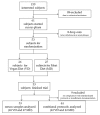Vitamin B12 Status Upon Short-Term Intervention with a Vegan Diet-A Randomized Controlled Trial in Healthy Participants
- PMID: 31752105
- PMCID: PMC6893687
- DOI: 10.3390/nu11112815
Vitamin B12 Status Upon Short-Term Intervention with a Vegan Diet-A Randomized Controlled Trial in Healthy Participants
Abstract
Vegans are at an increased risk for certain micronutrient deficiencies, foremost of vitamin B12. Little is known about the short-term effects of dietary change to plant-based nutrition on vitamin B12 metabolism. Systemic biomarkers of vitamin B12 status, namely, serum vitamin B12 and holotranscobalamin, may respond quickly to a reduced intake of vitamin B12. To test this hypothesis, 53 healthy omnivore subjects were randomized to a controlled unsupplemented vegan diet (VD, n = 26) or meat-rich diet (MD, n = 27) for 4 weeks. Vitamin B12 status was examined by measurement of serum vitamin B12, holotranscobalamin (holo-TC), methylmalonic acid (MMA) and total plasma homocysteine (tHcy). Holo-TC decreased significantly in the VD compared to the MD group after four weeks of intervention, whereas metabolites MMA and tHcy were unaffected. Body weight remained stable in both groups. VD intervention led to a significant reduction of cholesterol intake, and adequate profiles of nutrient and micronutrient status. Lower intake of vitamin B12 was observed in VD, which was mirrored by a lower concentration of serum vitamin B12 and reduced holo-TC after 4 weeks. Plasma holo-TC may be a fast-responding biomarker to monitor adequate supply of vitamin B12 in plant-based individuals.
Keywords: fatty acids; holotranscobalamin; micronutrient; vegan nutrition; vitamin B12.
Conflict of interest statement
The authors declare no conflict of interest.
Figures








Similar articles
-
Impact of vitamin B12 supplement intake cessation on vitamin B12 status in a healthy vegan: A close interval monitoring case study.Nutrition. 2024 Sep;125:112498. doi: 10.1016/j.nut.2024.112498. Epub 2024 May 7. Nutrition. 2024. PMID: 38833779
-
Vitamin B12 and folate status in Spanish lacto-ovo vegetarians and vegans.J Nutr Sci. 2019 Feb 26;8:e7. doi: 10.1017/jns.2019.2. eCollection 2019. J Nutr Sci. 2019. PMID: 30828450 Free PMC article.
-
The influence of a whole food vegan diet with Nori algae and wild mushrooms on selected blood parameters.Clin Lab. 2014;60(12):2039-50. doi: 10.7754/clin.lab.2014.140527. Clin Lab. 2014. PMID: 25651739
-
The application and interpretation of laboratory biomarkers for the evaluation of vitamin B12 status.Ann Clin Biochem. 2025 Jan;62(1):22-33. doi: 10.1177/00045632241292432. Epub 2024 Oct 27. Ann Clin Biochem. 2025. PMID: 39367523 Free PMC article. Review.
-
Vitamin B12-Related Biomarkers.Food Nutr Bull. 2024 Jun;45(1_suppl):S28-S33. doi: 10.1177/03795721241227114. Food Nutr Bull. 2024. PMID: 38987873 Review.
Cited by
-
The importance of vitamin B12 for individuals choosing plant-based diets.Eur J Nutr. 2023 Apr;62(3):1551-1559. doi: 10.1007/s00394-022-03025-4. Epub 2022 Dec 5. Eur J Nutr. 2023. PMID: 36469110 Free PMC article.
-
Correlates of serum holo-Transcobalamin in the elderly general population.Eur J Nutr. 2025 Aug 31;64(6):270. doi: 10.1007/s00394-025-03789-5. Eur J Nutr. 2025. PMID: 40886190 Free PMC article.
-
A Dietitian-Led Vegan Program May Improve GlycA, and Other Novel and Traditional Cardiometabolic Risk Factors in Patients With Dyslipidemia: A Pilot Study.Front Nutr. 2022 Mar 24;9:807810. doi: 10.3389/fnut.2022.807810. eCollection 2022. Front Nutr. 2022. PMID: 35399690 Free PMC article.
-
Reducing meat and/or dairy consumption in adults: a systematic review and meta-analysis of effects on protein intake, anthropometric values, and body composition.Nutr Rev. 2024 Feb 12;82(3):277-301. doi: 10.1093/nutrit/nuad055. Nutr Rev. 2024. PMID: 37236631 Free PMC article.
-
Changes in Gut Microbiota after a Four-Week Intervention with Vegan vs. Meat-Rich Diets in Healthy Participants: A Randomized Controlled Trial.Microorganisms. 2021 Mar 31;9(4):727. doi: 10.3390/microorganisms9040727. Microorganisms. 2021. PMID: 33807447 Free PMC article.
References
-
- Šimčikas S. Animal Charity Evaluators Is the Percentage of Vegetarians and Vegans in the U.S. Increasing? [(accessed on 21 March 2019)]; Available online: https://animalcharityevaluators.org/blog/is-the-percentage-of-vegetarian....
-
- Berlin J. Skopos Group 1,3 Millionen Deutsche Leben Vegan. [(accessed on 21 March 2019)]; Available online: https://www.skopos-group.de/news/13-millionen-deutsche-leben-vegan.html.
Publication types
MeSH terms
Substances
LinkOut - more resources
Full Text Sources

